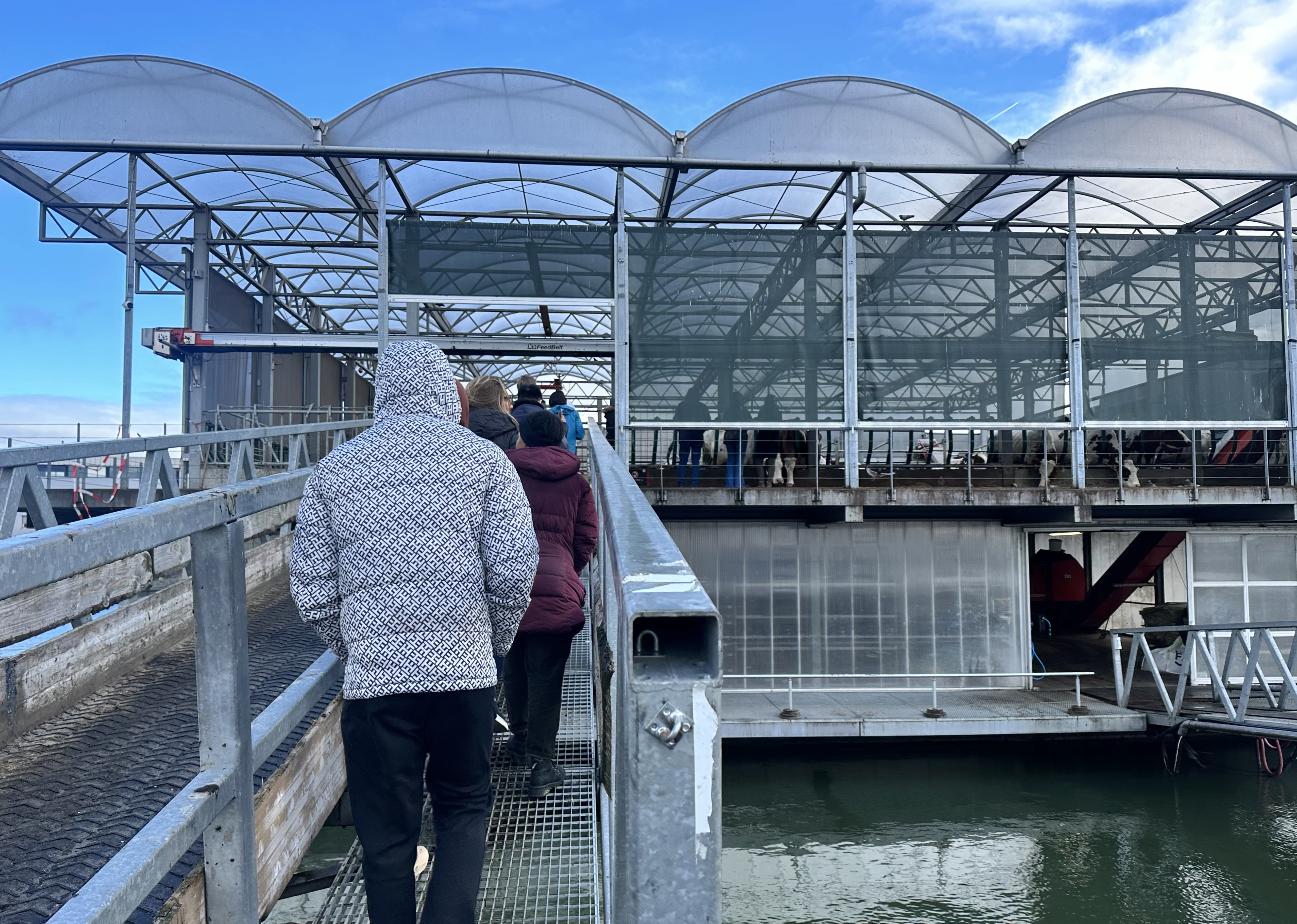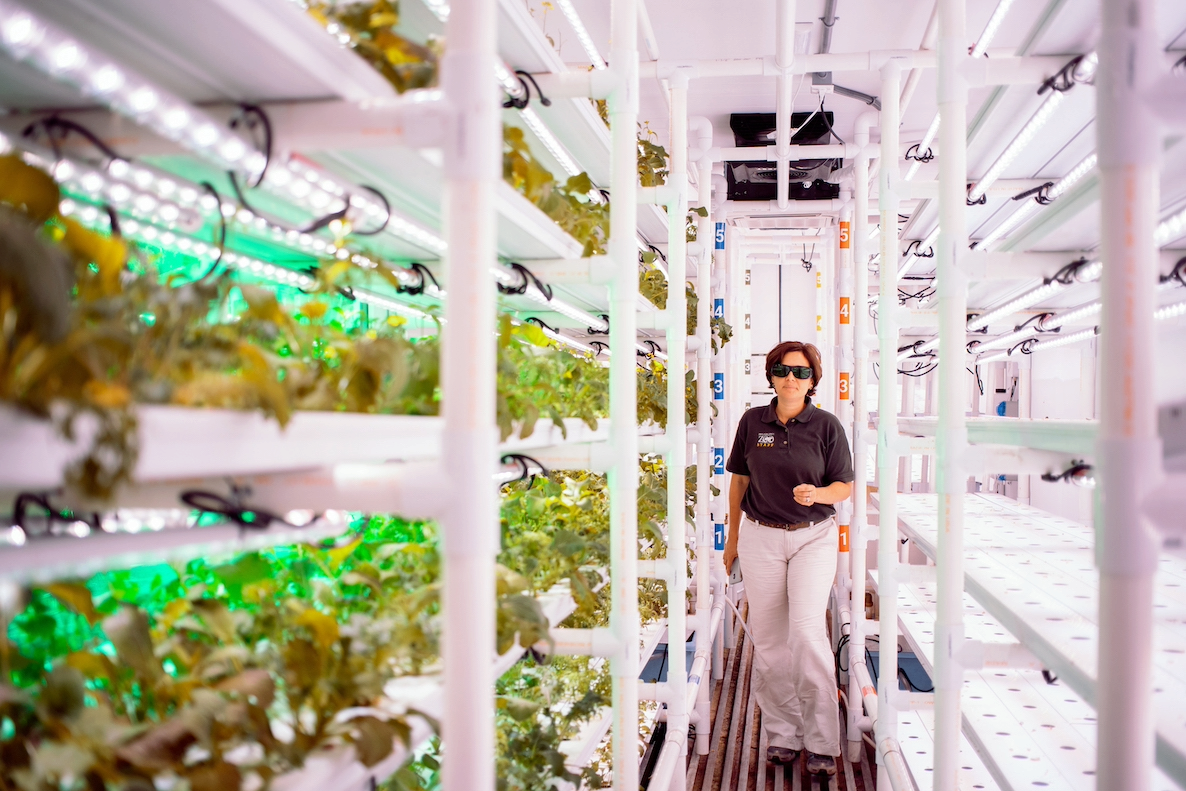The ESG Initiative at the Wharton School
Turner ESG Student Blogs
The Future of Food is Floating… So How do we Sell it?
Turner ESG Fellow Marielle Kang, C’24, investigates how climate adaptive agricultural technologies can solve for some of our most complex environmental and social issues.
The future of food is floating. It’s not every day that one may see a farm floating atop the surface of the water, its cows seemingly unaffected by its novelty. Almost immediately upon arrival in the Netherlands with Dr. Simon Richter’s Penn Global Seminar on climate resilience and adaptation, I had the opportunity to visit Rotterdam’s Floating Farm. Created in the aftermath of 2012 Hurricane Sandy thousands of miles away by Peter and Minke van Wingerden, the Floating Farm is a climate adaptive dairy farm, designed to move up and down with the tides of the Merwehaven Harbor. The Floating Farm serves a local customer base, minimizing extensive transportation of finished goods and, with it, the farm’s carbon footprint. The farm boasts numerous renewable energy sources and collects rainwater for filtration and reuse in its operations. It leverages local food waste donations to feed its cattle and processes manure to be sold as pellets. Aside from its specialization in dairy products, the farm utilizes a vertical farming system, which it hopes to expand in the future.

Traditional agriculture is accountable for numerous environmental issues, including soil degradation and water pollution. Amongst the growing severity of the global warming crisis, the food industry is responsible for approximately 26 percent of all global greenhouse gas emissions. The challenge that traditional farming poses amongst the climate crisis is not only recognized in the Netherlands. Locally, the Philadelphia Zoo launched its vertical farm in 2019. I had the opportunity to learn about the zoo’s sustainable project from Kristen Waldron, Chief of Staff at the zoo, during her visit with the Turner ESG Fellowship program at the Wharton School. Enclosed within an ebb and flow system inside of a shipping container, vegetables are hydroponically grown to help feed animals at the zoo. The zoo also works with the local community to provide educational programming. Hydroponics is a vertical farming technique that uses a water-based nutrient solution as a medium for growth instead of soil. The hydroponic ebb and flow model features frequent pumping and filtration of the nutrient solution through the plants’ root systems. The utility of this method significantly decreases the use of water and increases productivity per unit area, requiring less space and localizing the food production process in urban spaces.

If the future of food is floating, where are all the floating farms today? Where are all the hydroponic gardens? At first glance, these climate adaptive agricultural technologies seem to be extremely profitable. Both the Floating Farm and the Philadelphia Zoo leverage methods that increase productivity and exhibit innovative and novel food systems that are attractive to tourists.
The Floating Farm further takes advantage of its position within the community as the recipient of food waste donations while also reaping profits from its animals’ waste. However, both the Floating Farm’s Minke can Wingerden and the Philadelphia Zoo’s Kristen Waldron acknowledge the high financial barriers to entry in the design and installation of these technologies. Both systems are perceived as research spaces as opposed to profitable corporations, requiring increases in scale to support a viable business model. Where traditional horticulture reaps relatively small profit margins, hydroponic farms are at an even higher risk of becoming cost inefficient because of their heavy reliance on technology.
In their 2021 study of the up-scaling potential of vertical farms, Daniel Petrovics and Mendel Giezen utilize a three tier system to analyze vertical farms. At the “niche level,” or in the early innovation phase, they prescribe five major integrative functions that the farm must fulfill: marketability, environmental sustainability, built context, education, and community engagement. Petrovics and Giezen’s research, at least at the “niche level,” prompts vertical farmers to lean into environmental sustainability, whether that take the form of marketing crops as more sustainable than traditional methods, improving the system to be more sustainable, or leveraging external factors such as waste to become more sustainable. On the condition that the farm does not become exceedingly complex beyond management capacity, the up-scaling potential of a vertical farm lies in its farmer’s ability to embrace this value. By considering educational and community engagement, farms are better able to increase market acceptance of the technology necessary in applying hydroponic methods. However, a study conducted that same year by Gastón Ares, Birgit Ha, and Sara R. Jaeger on consumer attitudes towards vertical farms suggests the general acceptance of hydroponically grown produce in the market on the basis of environmental sustainability, efficiency, food security, and methodology. How much more can a business rely on promoting sustainability and new technologies as a means to expanding its customer base?
The limiting factor does not lie in the acceptance of vertical farming methods but in their subsequent product prices. Moderately negative sentiments lie in the premium pricing necessary for the operation to be profitable. While Ares, Ha, and Jaeger conclude that above-average pricing was of below-average importance to the consumer, monetary markups would still have some impact on uptake. At the same time that premium pricing poses a threat to popular uptake, it may provide opportunities for success. Addressing the necessity of monetary markups in this space, Petrovics and Giezen’s research emphasizes the production of quality, high-value crops, such as those fit for extensive transit or for medicinal purposes. The Japanese strawberry company Oishii demonstrates how a vertical farm may yield success through the creation of a luxury product. Originally selling its product for $5 per strawberry, Oishii has perfected the pollination process and consistency of its operations, creating the perfect conditions to grow the Omakase and Koyo varieties native to Japan in the United States. As the expansion of its operations has allowed it, Oishii has reduced its price to $2.50 per strawberry since the creation of its first farm in 2019 and has future goals to make its product more accessible to a wider market as opposed to marketing it as a premium product.10, 11, 12
Food is a basic need. In the context of climate change, rising sea levels, and booming populations, the ability to meet this demand using sustainable and climate adaptive methods like hydroponics is imperative. As a business venture, however, hydroponic systems are costly, and its products often sell at a premium. While the initial marketing of hydroponically grown food products as luxury goods enables companies to expand and ultimately transition its products to a commodity, the ethical question still stands: should sustainably-grown food be reduced to a luxury for those who can afford it? Some vertical farming companies have certainly succeeded in its sale of commodity crops; though given the cost to enter the market, these companies are likely the exception as opposed to the norm. It is only when the government prioritizes the creation of a sustainable food system that we might see one in the United States. Until monetary policy reflects these values, the future of food, while floating, is also unattainable for the everyday consumer.
By Marielle Kang
Views and opinions expressed here are those of the author and do not necessarily reflect the official position of the ESG Initiative at the Wharton School or the Wharton School.
Turner ESG Fellows

Turner ESG Fellows are a group of 20-25 undergraduates across Penn who participate in a year-long program of speaker sessions, networking opportunities, and professional development across many ESG topics. Alongside their peers, they develop a working knowledge of real-world environmental, social, and governance topics, learn about different ESG career options both in academia and industry, and network with other students, faculty, and professionals. They also benefit from mentorship and community-building opportunities, led by our returning Turner ESG Senior Fellows.
Marielle Kang,
C’ 24

Marielle is a senior at the University of Pennsylvania, studying Environmental Studies with a concentration in Sustainability and Environmental Management and pursuing minors in Urban Studies and Economic Policy. Her professional interests include risk management, corporate sustainability, insurance, and finance. In her academic pursuits, she enjoys exploring her interest in social and environmental justice, urban gardens, agricultural innovation, and sustainability.

The support and vision of impact investor Bobby Turner, W’84, catalyzed the launch of the Turner Environment, Social and Governance (ESG) Fellows.
As a longtime supporter of social impact activities at Wharton, Turner – CEO of Turner Impact Capital – is an example of, as Joseph Wharton said, harnessing the power of business to “solve the social problems incident to our civilization.” He also helps inform the ongoing priorities and future direction of the Wharton School as a member of the board of overseers. The ESG Initiative is very grateful to Lauren Golub Turner, W’85, and Bobby Turner, W’84 for their support.


